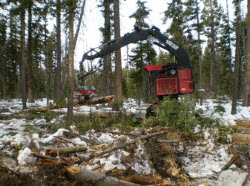
National Fire Plan Success Story
Stewardship Hazardous Fuels Reduction
Umatilla National Forest, Oregon
National Fire Plan - Fuels Reduction
2009

Thinning operation.
The Umatilla National Forest has been successfully using Stewardship Authority to complete hazardous fuels reduction treatments for the past five years. This contracting method has allowed the Forest to tackle major ongoing forest management problems: overstocked stands resulting from fire exclusion, and the excessive tons of dead and downed material from disease and insect infestations over the past 30 years. The challenge has been how to pay for removal of this low valued material.
The Forest determined that the best way to attain quality work at a fair and reasonable price was to develop a process in which the Government could “share in the risk” of the fluctuating fiber markets. By using an Integrated Resource Service Contract (IRSC), the Government contracts with loggers to remove the material and deliver itto the purchasers. The purchasers bid on the material, which is primarily chip and hog fuel, with a minor amount of small diameter saw logs. Given the highly volatile market for this material, the Government assumes the market risk by separating the logs from the logger. The result is a reduction in hazardous fuels and the likelihood of high intensity wildfire.
Initially, appropriated hazardous fuels dollars, agency trust funds and Secure Rural School and Community Self-Determination Act Title II grants were used to pay the loggers to thin and remove trees. The receipts from the sale of the product were placed in an account used to pay for additional acres of fuels treatment. Thus the initial investment has been “rolled over” several times, resulting in more acres restored and job stability in the contract workforce.
This single entry process is less expensive and has more immediate and predictable results than other options, such as multiple projects to first thin, next pile slash, and then burn the slash. The latter approach can take several years and be hindered by local smoke restrictions.
To-date, the Umatilla National Forest has treated 4,000 acres using the IRSC. The overall cost per acre started at $1,009, but once the retained receipts are applied to the cost it was an average of $375/acre. About 2,500 log truck loads of saw and non-saw material have been delivered, removing 64,000 tons of fuel material from the National Forest. The work has been sustainable for the past 5 years, resulting in an average of 25 jobs each year in the woods, and has provided wood products for the local processing plants as well.
Please call Scott McDonald at (541) 427-5332 with questions about the stewardship hazardous Fuels program on the Umatilla National Forest.